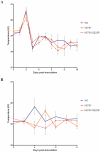Role of permissive neuraminidase mutations in influenza A/Brisbane/59/2007-like (H1N1) viruses
- PMID: 22174688
- PMCID: PMC3234239
- DOI: 10.1371/journal.ppat.1002431
Role of permissive neuraminidase mutations in influenza A/Brisbane/59/2007-like (H1N1) viruses
Abstract
Neuraminidase (NA) mutations conferring resistance to NA inhibitors were believed to compromise influenza virus fitness. Unexpectedly, an oseltamivir-resistant A/Brisbane/59/2007 (Bris07)-like H1N1 H275Y NA variant emerged in 2007 and completely replaced the wild-type (WT) strain in 2008-2009. The NA of such variant contained additional NA changes (R222Q, V234M and D344N) that potentially counteracted the detrimental effect of the H275Y mutation on viral fitness. Here, we rescued a recombinant Bris07-like WT virus and 4 NA mutants/revertants (H275Y, H275Y/Q222R, H275Y/M234V and H275Y/N344D) and characterized them in vitro and in ferrets. A fluorometric-based NA assay was used to determine Vmax and Km values. Replicative capacities were evaluated by yield assays in ST6Gal1-MDCK cells. Recombinant NA proteins were expressed in 293T cells and surface NA activity was determined. Infectivity and contact transmission experiments were evaluated for the WT, H275Y and H275Y/Q222R recombinants in ferrets. The H275Y mutation did not significantly alter Km and Vmax values compared to WT. The H275Y/N344D mutant had a reduced affinity (Km of 50 vs 12 µM) whereas the H275Y/M234V mutant had a reduced activity (22 vs 28 U/sec). In contrast, the H275Y/Q222R mutant showed a significant decrease of both affinity (40 µM) and activity (7 U/sec). The WT, H275Y, H275Y/M234V and H275Y/N344D recombinants had comparable replicative capacities contrasting with H275Y/Q222R mutant whose viral titers were significantly reduced. All studied mutations reduced the cell surface NA activity compared to WT with the maximum reduction being obtained for the H275Y/Q222R mutant. Comparable infectivity and transmissibility were seen between the WT and the H275Y mutant in ferrets whereas the H275Y/Q222R mutant was associated with significantly lower lung viral titers. In conclusion, the Q222R reversion mutation compromised Bris07-like H1N1 virus in vitro and in vivo. Thus, the R222Q NA mutation present in the WT virus may have facilitated the emergence of NAI-resistant Bris07 variants.
Conflict of interest statement
The authors have declared that no competing interests exist.
Figures





References
-
- Lackenby A, Hungnes O, Dudman SG, Meijer A, Paget WJ, et al. Vol. 13. Euro Surveill; 2008. Emergence of resistance to oseltamivir among influenza A(H1N1) viruses in Europe. pii: 8026. - PubMed
-
- Hurt AC, Ernest J, Deng YM, Iannello P, Besselaar TG, et al. Emergence and spread of oseltamivir-resistant A(H1N1) influenza viruses in Oceania, South East Asia and South Africa. Antiviral Res. 2009;83:90–93. - PubMed
Publication types
MeSH terms
Substances
Grants and funding
LinkOut - more resources
Full Text Sources
Other Literature Sources

